Multiplication is a wonderful little operation. Depending on the context, it can
- Scale or stretch a number
- Rotate a vector, without needing sine or cosine
And today we’ll see yet another use: listing combinations.
Revisiting multiplication has a few uses:
- It demystifies other parts of math. The binomial theorem, Boolean algebra (used in computer circuits) and even parts of calculus become easier with a new interpretation of “multiplication”.
- It keeps our brain fresh.Math gives us models to work with, and it’s good to see how one model can have many uses. Even a wrench can drive nails, once you understand the true nature of “being a hammer” (very Zen, eh?).
The long multiplication you learned in elementary school is quite useful: we can find the possibilities of several coin flips, for example. Let’s take a look.
You’ve Been Making Combinations All Along
How would you find 12 × 34? It’s ok, you can do it on paper:
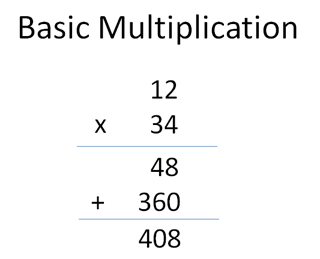
“Well, let’s see… 4 times 12 is 48. 3 times 12 is 36… but it’s shifted over one place, so it’s 360. Add 48 and 360 and you get… uh… carry the 1… 408. Phew.”
Not bad. But instead of doing 12 × 34 all at once, break it into steps:
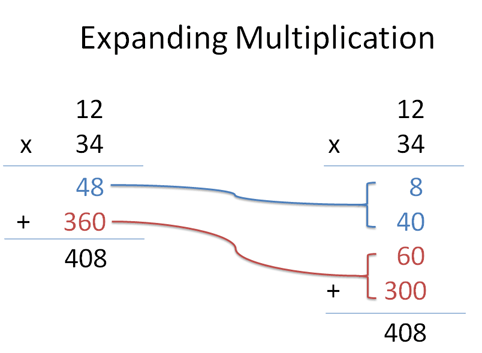
What’s happening? Well, 4 × 12 is actually “4 x (10 + 2)” or “40 + 8″, right? We can view that first step (blue) as two separate multiplications (4×10 and 4×2).
We’re so used to combining and carrying that we merge the steps, but they’re there. (For example, 4 × 17 = 4 x (10 + 7) = 40 + 28 = 68, but we usually don’t separate it like that.)
Similarly, the red step of “3 × 12″ is really “30 × 12″ — the 3 is in the tens column, after all. We get “30 x (10 + 2)” or “300 + 60″. Again, we can split the number into two parts.
What does this have to do with combinations? Hang in there, you’ll see soon enough.
Curses, Foiled Again
Take a closer look at what happened: 12 × 34 is really (10 + 2) x (30 + 4) = 300 + 40 + 60 + 8. This breakdown looks suspiciously like algebra equation (a + b) * (c + d):
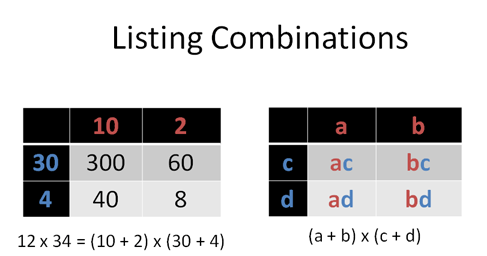
And yes, that’s what’s happening! In both cases we’re multiplying one “group” by another. We take each item in the red group (10 and 2) and combine it with every element of the blue group (30 and 4). We don’t mix red items with each other, and we don’t mix blue items with each other.
This combination technique is often called FOIL (first-inside-outside-last), and gives headaches to kids. But it’s not a magical operation! It’s just laying things out in a grid. FOIL is already built into the way we multiply!
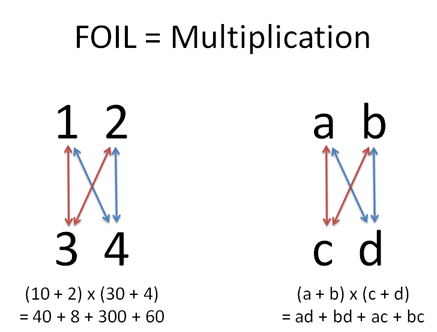
When doing long multiplication, we “know” we’re not supposed to multiply across: you don’t do 1 × 2, because they’re in the same row. Similarly, you don’t do a x b, because they’re in the same parenthesis. We only multiply “up and down” — that is, we need an item from the top row (1 or 2, a or b) and an item from the bottom row (3 or 4, c or d).
Everyday multiplication (aka FOIL) gives us a way to crank out combinations of two groups: one from group A, another from group B. And sometimes it’s nice having all the possibilities as an equation.
Examples Make It Click
Let’s try an example. Suppose we want to find every combination of flipping a coin twice. There’s a few ways to do it, like using a grid or decision tree:
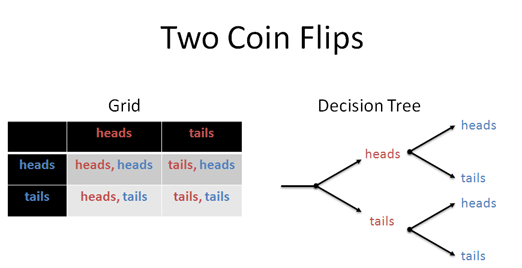
That’s fine, but let’s be different. We can turn the question into an equation using the following rules:
- addition = OR. We can get heads OR tails: (h+t)
- multiplication = AND. We have a first toss AND a second toss: (h+t) * (h+t)
Wow! How does this work?
Well, we really just want to crank out combinations, just like doing (a+b) * (c+d) = ac + bc + ad + bd. Looking carefully, this format means we pick a OR b, and combine it with one of c OR d.
When we see an addition (a+b), we know it means we must choose one variable: this OR that. When we see a multiplication (group1 * group2), we know it means we take one item from each: this AND that.
The shortcuts “AND = multiply” & “OR = add” are simply another way to describe the relationship inside the equation. (Be careful; when we say three hundred and four, most people think 304, which is right too. This AND/OR trick works in the context of describing combinations).
So, when all’s said and done, we can turn the sentence “(heads OR tails) AND (heads OR tails)” into:
![]()
And just for kicks, we can multiply it out:
![]()
The result “h2 + 2ht + t2” shows us every possibility, just like the grids and decision trees. And the size (coefficient) of each combination shows the number of ways it can happen:
- h^2: There’s one way to get two heads (h2 = hh = heads AND heads)
- 2ht: There’s two ways to get a head and tails (ht, th)
- t^2: There’s one way to get two tails (tt)
Neato. The sum of the coefficients is 1 + 2 + 1 = 4, the total number of possibilities. The chance of getting exactly one heads and one tails is 2/4 = 50%. We figured this out without a tree or grid — regular multiplication does the trick!
Grids? Trees? I Figured That Out In My Head.
Ok, hotshot, let’s expand the scope. How many ways can we get exactly 2 heads and 2 tails with 4 coin flips? What’s the chance of getting 3 or more heads?
Our sentence becomes: “(heads OR tails) AND (h OR t) AND (h OR t) AND (h OR t)”
![]()
Looking at the result (it looks hard but there are shortcuts), there are 6 ways to get 2 heads and 2 tails. There’s 1 + 4 + 6 + 4 + 1 = 16 possibilities, so there’s only a 6/16 = 37.5% chance of having a “balanced” result after 4 coin flips. (It’s a bit surprising that it’s much more likely to be uneven than even).
And how many ways can we get 3 or more heads? Well, that means any components with h3 or h4: 4 + 1 = 5. So we have 5/16 = 31.25% chance of 3 or more heads.
Sometimes equations are better than grids and trees — look at how much info we crammed into a single line! Formulas work great when you have a calculator or computer handy.
But most of all, we have another tool in our box: we can write possibilities as equations, and use multiplication to find combinations.
Where Next?
There’s a few areas of math that benefit from seeing multiplication in this way:
Binomial Theorem. This scary-sounding theorem relates (h+t)^n to the coefficients. If you’re clever, you realize you can use combinations and permutations to figure out the exponents rather than having to multiply out the whole equation. This is what the binomial theorem does. We’ll cover more later — this theorem shows up in a lot of places, including calculus.
Boolean Algebra. Computer geeks love converting conditions like OR and AND into mathematical statements. This type of AND/OR logic is used when designing computer circuits, and expressing possibilities with equations (not diagrams) is very useful. The fancy name of this technique is Boolean Algebra, which we’ll save for a rainy day as well.
Calculus. Calculus gets a double bonus from this interpretation. First, the binomial theorem makes working with equations like x^n much easier. Second, one view of calculus is an “expansion” of multiplication. Today we got practice thinking that multiplication means a lot more than “repeated addition”. (“12 × 34″ means 12 groups of 34, right?)
More advanced combinations. Let’s say you have 3 guests (Alice, Bob, and Charlie) and they are bringing soda, ice cream, or yogurt. Someone knocks at the door — what are the possibilities? (a + b + c) * (s + i + y). The equation has it all there.
So you can teach an old dog like multiplication new tricks after all. Well, the tricks have always been there — it’s like discovering Fido has been barking poetry in morse code all this time.
And come to think of it, maybe we’re the animal that learned a new trick. The poetry was there, staring us in the face and we just didn’t recognize it (12 × 34 is based on combinations!). I know I had some forehead-slapping moments after seeing how similar combinations and regular multiplication really were.
Happy math.



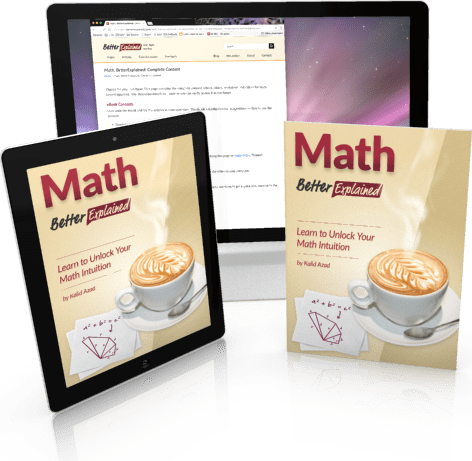
Leave a Reply
37 Comments on "How To Understand Combinations Using Multiplication"
Excellent discussion. I would also add the example of genetics. A woman(XX) mates with a man (XY) to achieve (XX + XY + YX + XX) = (2XX + 2XY)–what do you know, equal odds of a boy or girl.
I remember the trick was useful during my high school biology class when we had to cross 4 traits (say AaBc crossed with aabC). Others started drawing out Punnet squares, but I used the algebraic notation plus a symbolic calculator.
Nice explanation. Your figure are really nice. Which program you use to draw those figures?
@Presh: That’s a great use of this trick! I had completely forgotten about mixing genes in biology, but that’s exactly it. The child gets (x OR x) AND (x or y) = (x + x)*(x+y) = 2xx + 2xy, or an equal chance as you say.
@sgwong: Glad you liked it — I use PowerPoint 2007 to make the diagrams.
I came to your website after a while Kalid. And the only word that came to mind was “COOL”. Was very busy during the past month on my job so it was a great refresher coming back and brushing up my combinations and probability :)….am really looking forward to more of your math posts that have once again sparked my interest in math after my university professors had managed to kill it. In the meanwhile I will be treating myself to some of your other posts which I have missed over the course of the past month.
Your fan from Pakistan
Hi Mohammad, thanks for the wonderful note! Glad you’re enjoying the articles.
Hi Khalid
You are real thinker! Trying to study math again,after 10 yrs, at college is a real nightmare! I fell in love with math again after 10 yrs after reading you posts! You have an amazing talent to dissect and disseminate what looks like complex theories.
Thank you very much for sharing your thoughts. Its not just about the content of the posts, but a whole new way of thinking that you opened up.
Best Regards
Meera
Thanks for the kind words Meera! Really glad you were able to rekindle your interest :).
[…] Following on from recent posts about expanding brackets and the binomial expansion, betterexplained uses the same principles to discuss combinations (a key component of the binomial expansion when you’re using positive integer powers). I think this is an interesting way of seeing how you work out nCr. […]
I see that the co-efficient in the expansion gives the number of options of re-arranging. Doesn’t this seem like a permutation rather than a combination? Isn’t it giving us all possibilities of re-arranging? Yet it yields the same value as combination. (ex: how many ways to pick one from 3 = coefficient in 2nd term in the expansion of (1+x)^3) I just can’t understand why they are the same number when one seems like permutation and the other a combination?? Any help would be amazing. That was a great read by the way. Thank you
@Jaq: Great question — the expansions for the Binomial Theorem can be tricky.
Here’s one way to think about it. For (a+b)^10, it means:
Choose a or b, 10 times.
Suppose we want to know the coefficient for a^3 * b^7. The neat thing is that picking 3 elements from 10 to “become a’s” means the other 7 automatically become b’s. They have to, since we want a^3*b^7; every element is used.
So how many ways can we pick 3 items from 10? At first we’d think 10*9*8 — a permutation.
But because we’re multiplying, the order doesn’t matter: Saying element 1, 2, and 3 become a’s (in that order) is the same as saying element 3, 2 and 1 become a’s in that order.
So, we do C(10,3) which is the number of groups of 3 we can pick from 10. Permutations would be important if the order of multiplication mattered, but they don’t in this case so we have to divide by the redundancies.
Hope that helps!
I have a question Sir –
I have 10 numbers for example – 1,2,3, 4,5, 6,7,8,9,10 arranged in two sets of five numbers each
I arrange the numbers – in the following format
(1 2 3 4 5 ) and ( 6 7 8 9 10)
A = 1 , A = 6
B= 2 , B= 7
C=3 , C = 8
D= 4 , D= 9
E = 5 , E = 10
TASK – Arrange the numbers into groups of five making sure that EACH combination of five numbers reflects ABCDE
NOTE – The format ABCDE must be strictly adhered to when arranging the numbers in groups of five
Some examples are – (1,2,3,4,5) , (6,7,8,9, 10), ( 1,2,3,9,10) (6, 7, 8, 4,5)
QUESTION- HOW MANY POSSIBLE OTHER ARRANGEMENTS ARE THERE IN THE ABOVE CASE.. AND WHAT ARE THEY?
COULD THIS BE DONE FOR 16 numbers arranged in 2 sets of eight and how would that case be solved ?
i recieved very nice explanation on permutation and combination
I can’t seem to understand how to solve a problem similar to the following:
If there are X different items and I need to determine the number of subgroups containing at least Y of these items, how would I go about doing that? The actual problem asks for the above with x=6 and y=2, and the answer is 57 b/c they do 2^6 – 6 – 1. But why do they do that? I don’t understand, please help!!
Many thanks,
soni
I am still confused with permutation. My son has a math problem –
How many different arrangements can be made with the letters in the word MOVIE?
I don’t see how they get the answer.
Thanks
Trisha
Really helpful..m very bad at permutations and combinations like difficult problems in GMAT wher you have 5 married couples and you pick 3 people out .what is the prob.niether is married to each other.can you help me an easy way to silve these problems.will be really much of help.Thanks in advance
This is really great for me it is helpful to me. Thanks to the group that came up with this it is great really!!!!!!!!!!!!!!!!!!!
@Brianna: Awesome, glad it helped!
[…] Navigate a Grid Using Combinations And Permutations […]
Hey Kalid,
Great work :-)
one quesion: In how many ways can a batsman score 200 hitting sixes and fours only……
if he hits x fours and y sixes
4x + 6y=200
2x+3y=100
can we solve this equation using permutation and combination??? or do we have to go by the method of actually counting the ways of sixes and fours…..
Regards
Ann
@Charles (comment #10):
I think your problem is that if you choose an element from one set, say A, you can’t choose only A from the other, while being forced to choose every other element. This means you begin with choosing a single element from either set and four on four of the other + two from either and three on three from the other, an so on…
It boils down to {2 (5C1*4C4 + 5C2*3C3 + 5C3*2C2 + 5C4*1C1)}. Or,
Simply, 2 (5 + 10 + 10 + 5) = 60 choices.
@Ann:
Hi, I think I can answer your question. It looks simpler if you look at it as this:
What’s the max. number of sixes that can be hit? 32. (since that makes it 32*6 = 192, from where we can arrive at a perfect 200 by adding 4s). To make it a perfect 200 each time, you go on replacing two 6s with three 4s, which can be done 16 times.
[…] is often seen as AND. Component A must be there AND Component B must be there. If either condition is false, the system […]
Thank you for your explanation.
Do you mind reading this post to see if it make sense? I’m not a person that is naturally comfortable with anything connected with Stats (I’m trying hard though).
On your comment about the binomial expansion : choose a or b 10 times?
Is it that you have an a OR b event and you are repeating this event 10 times. This means you are picking an outcome from each experiment. Then for each term you are counting the number of possible strings of experiments that lead to having say choosen three a’s.
Choosing 3 a’s forces you to have choosen 7 b’s as you need to choose one in each experiment.
Also it cannot be anything else as with our other hat one we are still talking about multiplication and the dimensions have to be consistant. Multiplication can be though of as finding the area/volume/measure of the “rectangliod” of the number of dimensions the same as the number of numbers you are multiplying. Addition can only be performed between things that agree in dimension (you can’t add a length and an area, what unit would you use to measure the sum?) and the same with its inverse subtraction. So even if you break up (a + b)^10 into a sum of other terms all the terms must still be the measure of a 10 dimensional “rectangliod”. This means they themselves are the product of 10 numbers multiplied.
You are also assuming the events to be independent. If you assume all events have equal likelyhood of occuring then you can find the probabilty of each outcome by dividing like you said. This is a way of working out all possible outcomes of a set of identical idepenent experiments?
When you generalise this to finding the outcomes if the experiments are not the same e.g roll a dice the flip a coin would be (a+b+c+d+e+f)*(x+y) the multiplication analogy holds (thousands etc.).
However if when you rolled the head matters then you loose a lot of the worth of this model (as you would be able to make the multiplication commute) and you are better of with the vector model. This is when you map each outcome, e.g. head, to a number on the cooridante axis. Then outcomes after say n experiments are all the points in R^n space. This is essentially what you are doing with the grid model.
The difference between combinations and multiplications are that the combinations of points in space (e.g (heads, tails) = (0,1) ) but multiplication is finding the area. If you were thinking about the probability of the events that would be the same as multiplication (at least with independent events) as it could be thought of a area in the same way.
“Even a wrench can drive nails, once you understand the true nature of “being a hammer” (very Zen, eh?).” Corollary …even a hammer can remove nails once you understand the true nature of being a lever.
@mark: Whoa… very nice :).
Greta article. One comment. Under ‘Where Next’ you wrote ‘ This is what the binomial theorem does. We’ll cover more later…’ Where does ‘more later’ refer to?
What would the number of combinations be to the two following questions…
*… There are 36 two sided objects. Every side is unique in pattern. If they remain in the same static sequence how many different combination of sides are there?
*… There are 49 cubes. Every side of all the cubes is unique in pattern. So there are 294 unique patterns in the set. Each cube can be re-arranged in the sequence of the 49 cubes and each side of every cube can be face-up. How many different combinations of the 49 cubes can be created using all sides of the cubes?